Report on Management Accounting Systems and Techniques for Business
VerifiedAdded on 2020/12/10
|17
|5429
|184
Report
AI Summary
This report provides a comprehensive analysis of management accounting systems and techniques, focusing on their application within an organizational context, using Italian Continental Stores as a case study. It explores the core concepts of management accounting, differentiating it from financial accounting and outlining various systems such as job costing, price optimization, inventory management, and cost accounting. The report delves into different reporting methods, including budget reports and inventory management reports. Furthermore, it examines cost calculation techniques like marginal and absorption costing, along with the advantages and disadvantages of planning tools used in budgetary control. The implementation of management accounting systems to address financial problems and challenges is also discussed, alongside an evaluation of these systems' effectiveness.
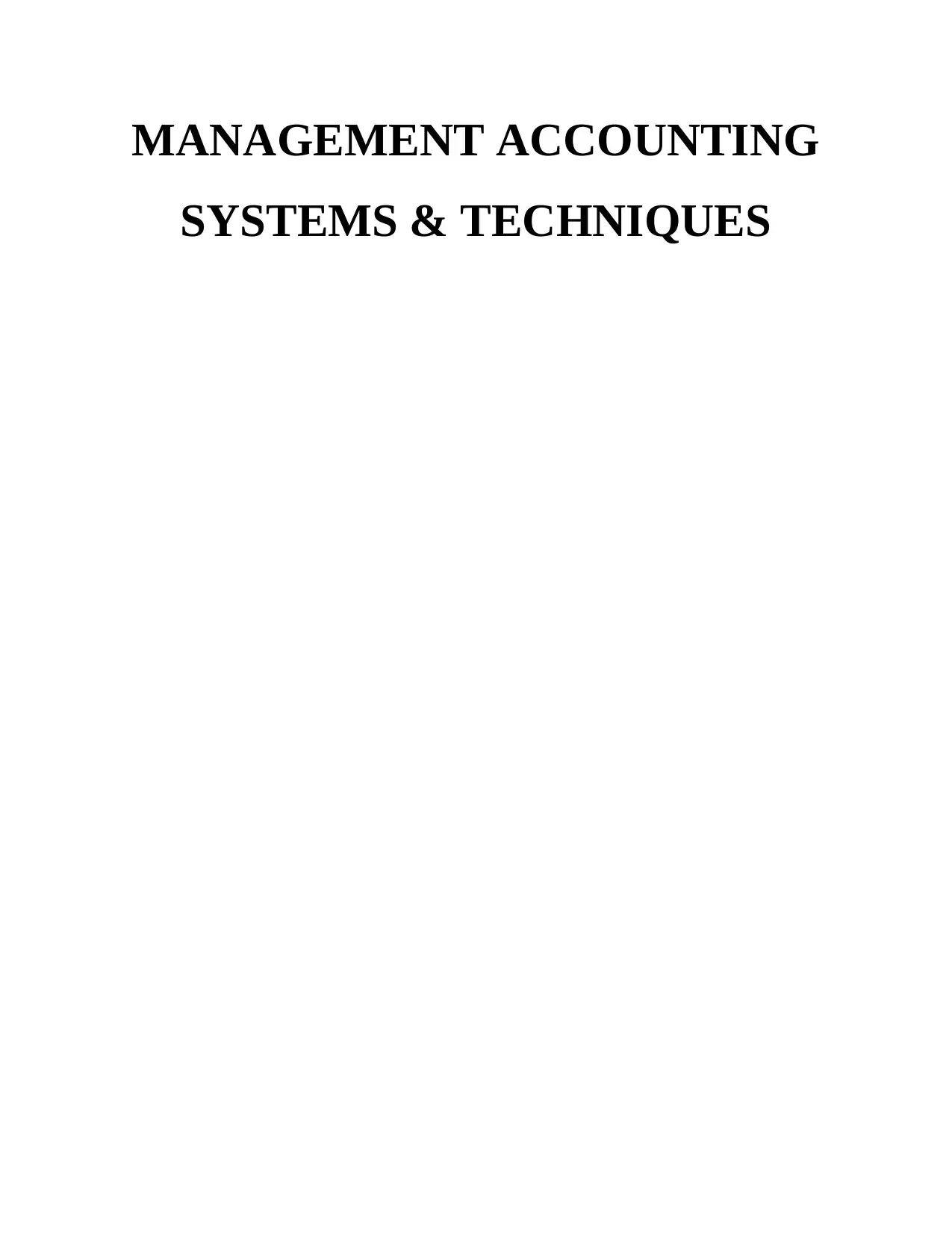
MANAGEMENT ACCOUNTING
SYSTEMS & TECHNIQUES
SYSTEMS & TECHNIQUES
Paraphrase This Document
Need a fresh take? Get an instant paraphrase of this document with our AI Paraphraser
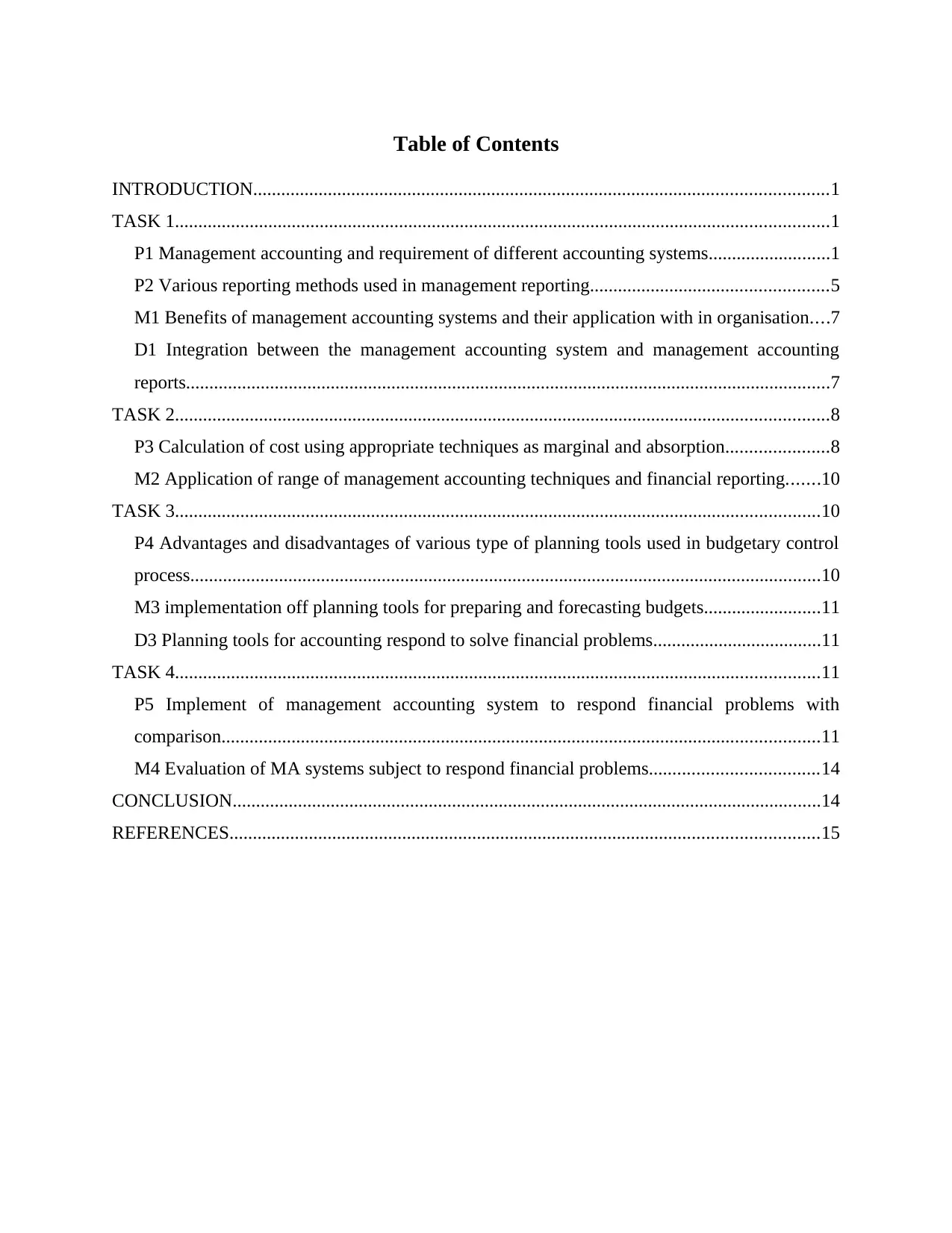
Table of Contents
INTRODUCTION...........................................................................................................................1
TASK 1............................................................................................................................................1
P1 Management accounting and requirement of different accounting systems..........................1
P2 Various reporting methods used in management reporting...................................................5
M1 Benefits of management accounting systems and their application with in organisation....7
D1 Integration between the management accounting system and management accounting
reports..........................................................................................................................................7
TASK 2............................................................................................................................................8
P3 Calculation of cost using appropriate techniques as marginal and absorption......................8
M2 Application of range of management accounting techniques and financial reporting.......10
TASK 3..........................................................................................................................................10
P4 Advantages and disadvantages of various type of planning tools used in budgetary control
process.......................................................................................................................................10
M3 implementation off planning tools for preparing and forecasting budgets.........................11
D3 Planning tools for accounting respond to solve financial problems....................................11
TASK 4..........................................................................................................................................11
P5 Implement of management accounting system to respond financial problems with
comparison................................................................................................................................11
M4 Evaluation of MA systems subject to respond financial problems....................................14
CONCLUSION..............................................................................................................................14
REFERENCES..............................................................................................................................15
INTRODUCTION...........................................................................................................................1
TASK 1............................................................................................................................................1
P1 Management accounting and requirement of different accounting systems..........................1
P2 Various reporting methods used in management reporting...................................................5
M1 Benefits of management accounting systems and their application with in organisation....7
D1 Integration between the management accounting system and management accounting
reports..........................................................................................................................................7
TASK 2............................................................................................................................................8
P3 Calculation of cost using appropriate techniques as marginal and absorption......................8
M2 Application of range of management accounting techniques and financial reporting.......10
TASK 3..........................................................................................................................................10
P4 Advantages and disadvantages of various type of planning tools used in budgetary control
process.......................................................................................................................................10
M3 implementation off planning tools for preparing and forecasting budgets.........................11
D3 Planning tools for accounting respond to solve financial problems....................................11
TASK 4..........................................................................................................................................11
P5 Implement of management accounting system to respond financial problems with
comparison................................................................................................................................11
M4 Evaluation of MA systems subject to respond financial problems....................................14
CONCLUSION..............................................................................................................................14
REFERENCES..............................................................................................................................15
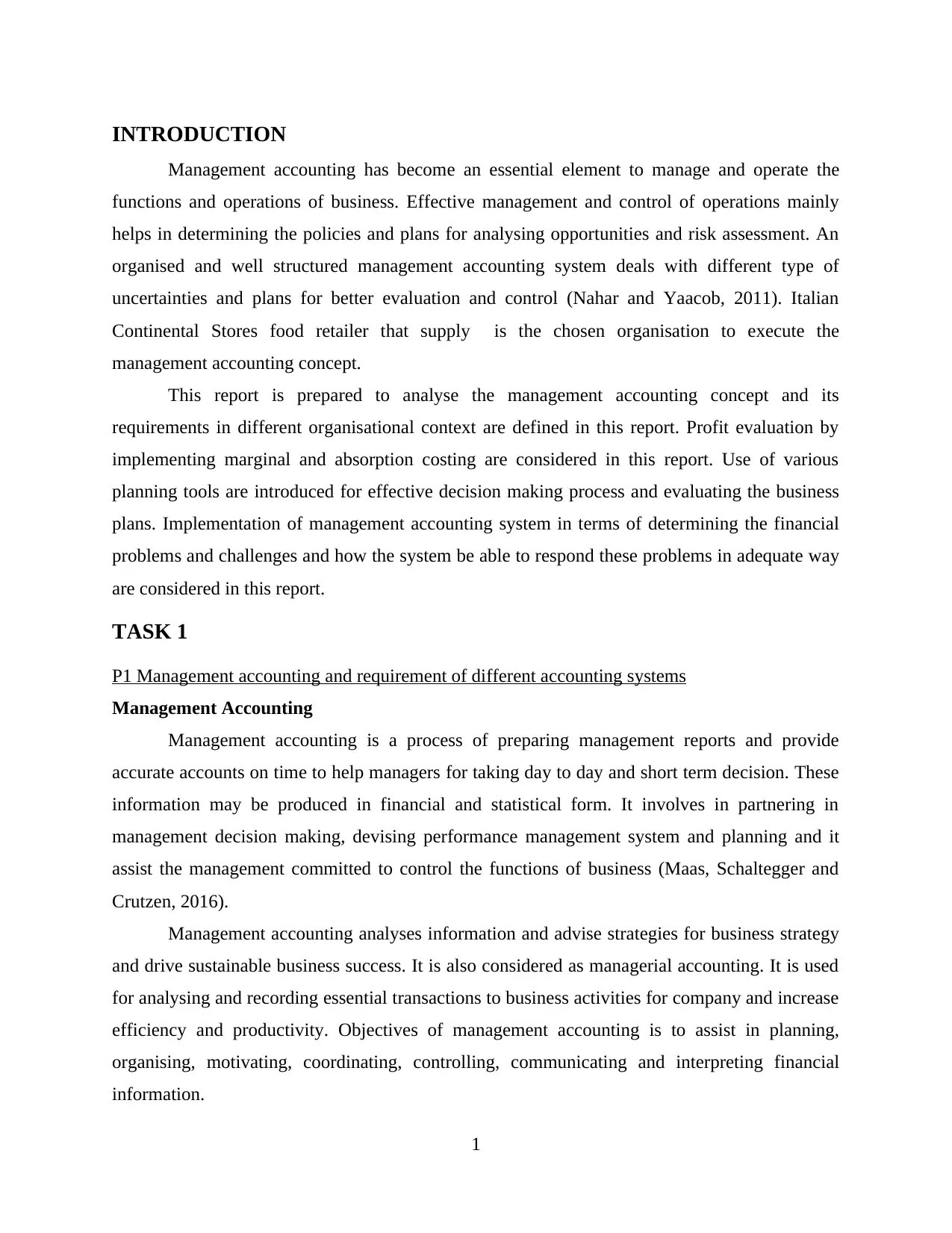
INTRODUCTION
Management accounting has become an essential element to manage and operate the
functions and operations of business. Effective management and control of operations mainly
helps in determining the policies and plans for analysing opportunities and risk assessment. An
organised and well structured management accounting system deals with different type of
uncertainties and plans for better evaluation and control (Nahar and Yaacob, 2011). Italian
Continental Stores food retailer that supply is the chosen organisation to execute the
management accounting concept.
This report is prepared to analyse the management accounting concept and its
requirements in different organisational context are defined in this report. Profit evaluation by
implementing marginal and absorption costing are considered in this report. Use of various
planning tools are introduced for effective decision making process and evaluating the business
plans. Implementation of management accounting system in terms of determining the financial
problems and challenges and how the system be able to respond these problems in adequate way
are considered in this report.
TASK 1
P1 Management accounting and requirement of different accounting systems
Management Accounting
Management accounting is a process of preparing management reports and provide
accurate accounts on time to help managers for taking day to day and short term decision. These
information may be produced in financial and statistical form. It involves in partnering in
management decision making, devising performance management system and planning and it
assist the management committed to control the functions of business (Maas, Schaltegger and
Crutzen, 2016).
Management accounting analyses information and advise strategies for business strategy
and drive sustainable business success. It is also considered as managerial accounting. It is used
for analysing and recording essential transactions to business activities for company and increase
efficiency and productivity. Objectives of management accounting is to assist in planning,
organising, motivating, coordinating, controlling, communicating and interpreting financial
information.
1
Management accounting has become an essential element to manage and operate the
functions and operations of business. Effective management and control of operations mainly
helps in determining the policies and plans for analysing opportunities and risk assessment. An
organised and well structured management accounting system deals with different type of
uncertainties and plans for better evaluation and control (Nahar and Yaacob, 2011). Italian
Continental Stores food retailer that supply is the chosen organisation to execute the
management accounting concept.
This report is prepared to analyse the management accounting concept and its
requirements in different organisational context are defined in this report. Profit evaluation by
implementing marginal and absorption costing are considered in this report. Use of various
planning tools are introduced for effective decision making process and evaluating the business
plans. Implementation of management accounting system in terms of determining the financial
problems and challenges and how the system be able to respond these problems in adequate way
are considered in this report.
TASK 1
P1 Management accounting and requirement of different accounting systems
Management Accounting
Management accounting is a process of preparing management reports and provide
accurate accounts on time to help managers for taking day to day and short term decision. These
information may be produced in financial and statistical form. It involves in partnering in
management decision making, devising performance management system and planning and it
assist the management committed to control the functions of business (Maas, Schaltegger and
Crutzen, 2016).
Management accounting analyses information and advise strategies for business strategy
and drive sustainable business success. It is also considered as managerial accounting. It is used
for analysing and recording essential transactions to business activities for company and increase
efficiency and productivity. Objectives of management accounting is to assist in planning,
organising, motivating, coordinating, controlling, communicating and interpreting financial
information.
1
⊘ This is a preview!⊘
Do you want full access?
Subscribe today to unlock all pages.

Trusted by 1+ million students worldwide
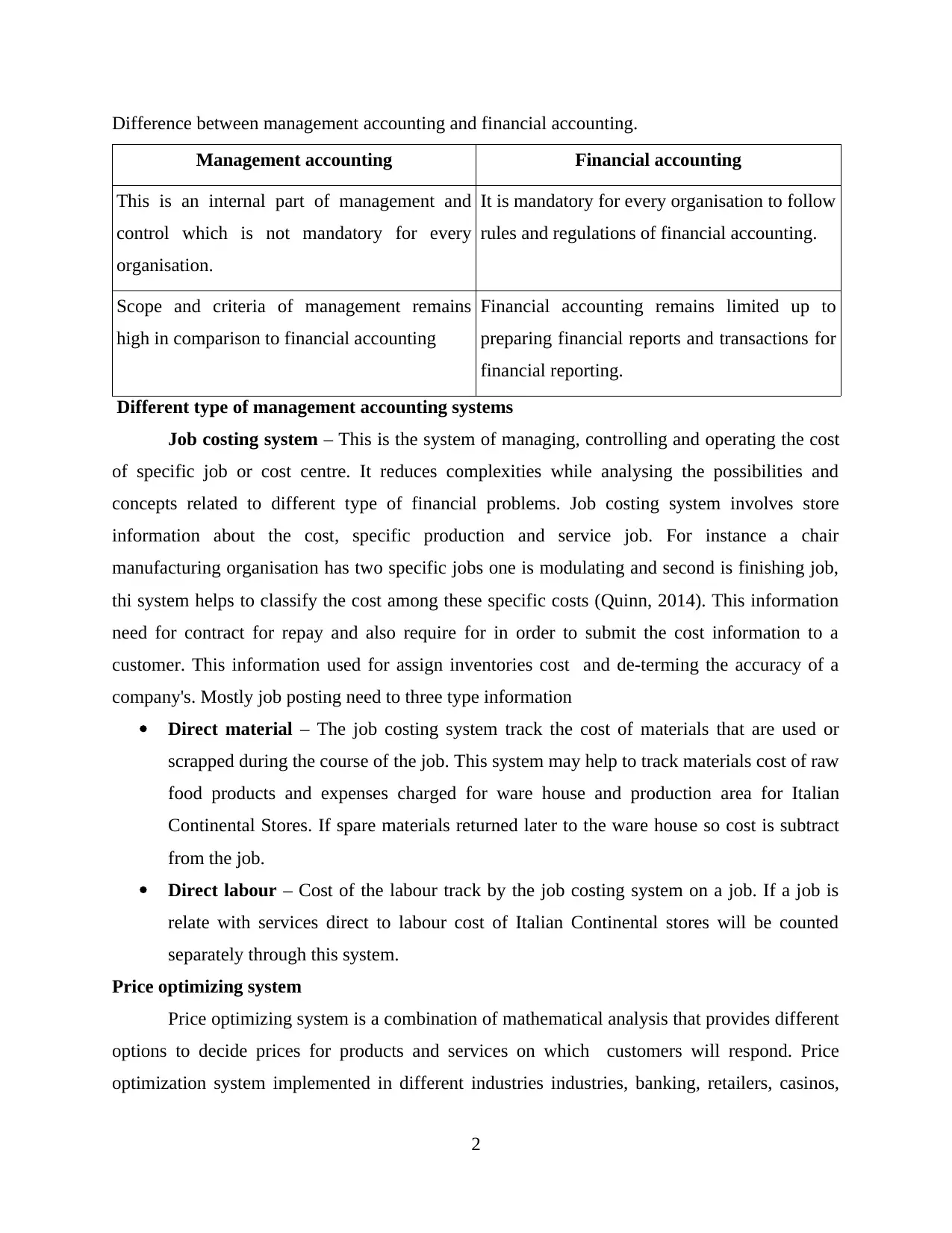
Difference between management accounting and financial accounting.
Management accounting Financial accounting
This is an internal part of management and
control which is not mandatory for every
organisation.
It is mandatory for every organisation to follow
rules and regulations of financial accounting.
Scope and criteria of management remains
high in comparison to financial accounting
Financial accounting remains limited up to
preparing financial reports and transactions for
financial reporting.
Different type of management accounting systems
Job costing system – This is the system of managing, controlling and operating the cost
of specific job or cost centre. It reduces complexities while analysing the possibilities and
concepts related to different type of financial problems. Job costing system involves store
information about the cost, specific production and service job. For instance a chair
manufacturing organisation has two specific jobs one is modulating and second is finishing job,
thi system helps to classify the cost among these specific costs (Quinn, 2014). This information
need for contract for repay and also require for in order to submit the cost information to a
customer. This information used for assign inventories cost and de-terming the accuracy of a
company's. Mostly job posting need to three type information
Direct material – The job costing system track the cost of materials that are used or
scrapped during the course of the job. This system may help to track materials cost of raw
food products and expenses charged for ware house and production area for Italian
Continental Stores. If spare materials returned later to the ware house so cost is subtract
from the job.
Direct labour – Cost of the labour track by the job costing system on a job. If a job is
relate with services direct to labour cost of Italian Continental stores will be counted
separately through this system.
Price optimizing system
Price optimizing system is a combination of mathematical analysis that provides different
options to decide prices for products and services on which customers will respond. Price
optimization system implemented in different industries industries, banking, retailers, casinos,
2
Management accounting Financial accounting
This is an internal part of management and
control which is not mandatory for every
organisation.
It is mandatory for every organisation to follow
rules and regulations of financial accounting.
Scope and criteria of management remains
high in comparison to financial accounting
Financial accounting remains limited up to
preparing financial reports and transactions for
financial reporting.
Different type of management accounting systems
Job costing system – This is the system of managing, controlling and operating the cost
of specific job or cost centre. It reduces complexities while analysing the possibilities and
concepts related to different type of financial problems. Job costing system involves store
information about the cost, specific production and service job. For instance a chair
manufacturing organisation has two specific jobs one is modulating and second is finishing job,
thi system helps to classify the cost among these specific costs (Quinn, 2014). This information
need for contract for repay and also require for in order to submit the cost information to a
customer. This information used for assign inventories cost and de-terming the accuracy of a
company's. Mostly job posting need to three type information
Direct material – The job costing system track the cost of materials that are used or
scrapped during the course of the job. This system may help to track materials cost of raw
food products and expenses charged for ware house and production area for Italian
Continental Stores. If spare materials returned later to the ware house so cost is subtract
from the job.
Direct labour – Cost of the labour track by the job costing system on a job. If a job is
relate with services direct to labour cost of Italian Continental stores will be counted
separately through this system.
Price optimizing system
Price optimizing system is a combination of mathematical analysis that provides different
options to decide prices for products and services on which customers will respond. Price
optimization system implemented in different industries industries, banking, retailers, casinos,
2
Paraphrase This Document
Need a fresh take? Get an instant paraphrase of this document with our AI Paraphraser
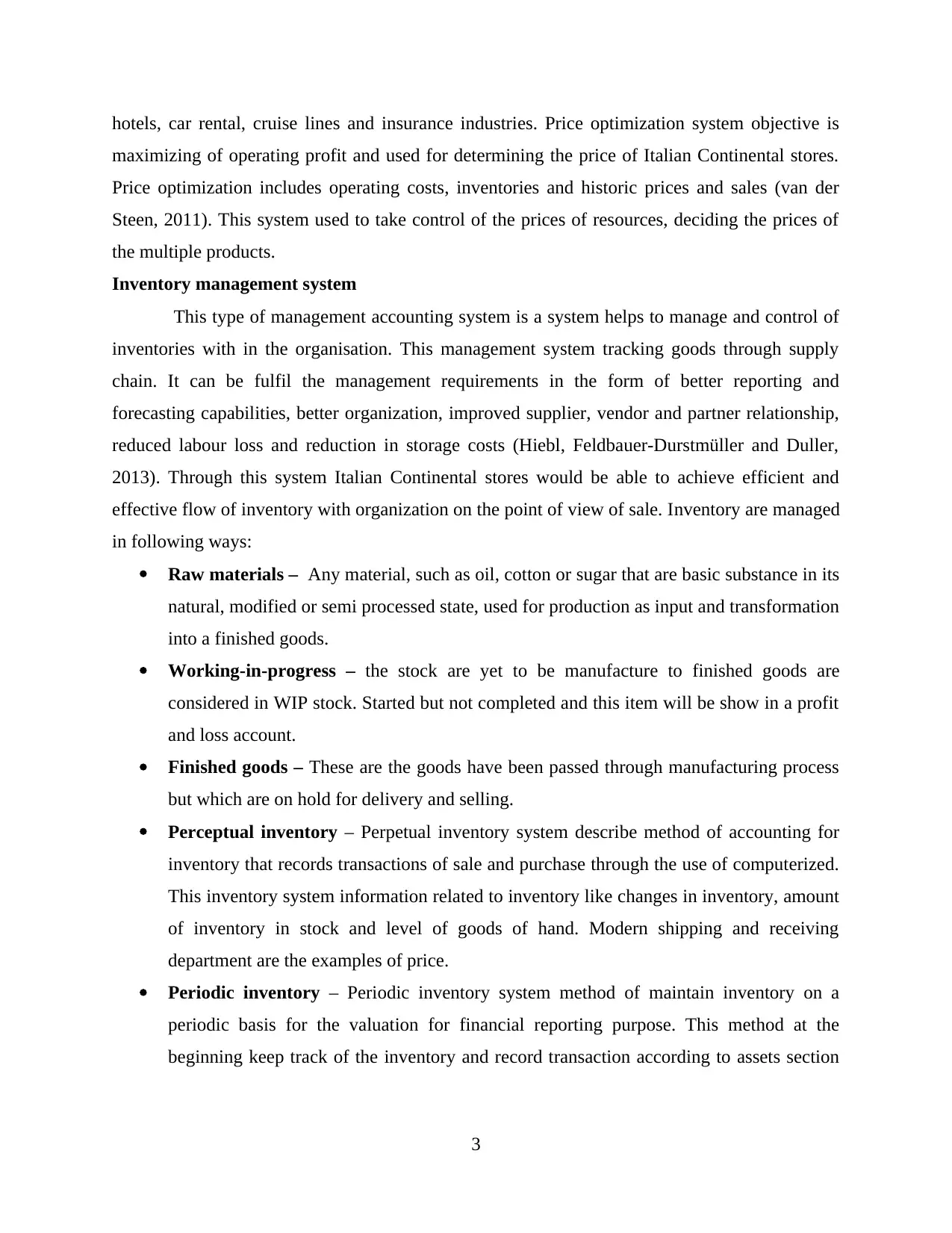
hotels, car rental, cruise lines and insurance industries. Price optimization system objective is
maximizing of operating profit and used for determining the price of Italian Continental stores.
Price optimization includes operating costs, inventories and historic prices and sales (van der
Steen, 2011). This system used to take control of the prices of resources, deciding the prices of
the multiple products.
Inventory management system
This type of management accounting system is a system helps to manage and control of
inventories with in the organisation. This management system tracking goods through supply
chain. It can be fulfil the management requirements in the form of better reporting and
forecasting capabilities, better organization, improved supplier, vendor and partner relationship,
reduced labour loss and reduction in storage costs (Hiebl, Feldbauer-Durstmüller and Duller,
2013). Through this system Italian Continental stores would be able to achieve efficient and
effective flow of inventory with organization on the point of view of sale. Inventory are managed
in following ways:
Raw materials – Any material, such as oil, cotton or sugar that are basic substance in its
natural, modified or semi processed state, used for production as input and transformation
into a finished goods.
Working-in-progress – the stock are yet to be manufacture to finished goods are
considered in WIP stock. Started but not completed and this item will be show in a profit
and loss account.
Finished goods – These are the goods have been passed through manufacturing process
but which are on hold for delivery and selling.
Perceptual inventory – Perpetual inventory system describe method of accounting for
inventory that records transactions of sale and purchase through the use of computerized.
This inventory system information related to inventory like changes in inventory, amount
of inventory in stock and level of goods of hand. Modern shipping and receiving
department are the examples of price.
Periodic inventory – Periodic inventory system method of maintain inventory on a
periodic basis for the valuation for financial reporting purpose. This method at the
beginning keep track of the inventory and record transaction according to assets section
3
maximizing of operating profit and used for determining the price of Italian Continental stores.
Price optimization includes operating costs, inventories and historic prices and sales (van der
Steen, 2011). This system used to take control of the prices of resources, deciding the prices of
the multiple products.
Inventory management system
This type of management accounting system is a system helps to manage and control of
inventories with in the organisation. This management system tracking goods through supply
chain. It can be fulfil the management requirements in the form of better reporting and
forecasting capabilities, better organization, improved supplier, vendor and partner relationship,
reduced labour loss and reduction in storage costs (Hiebl, Feldbauer-Durstmüller and Duller,
2013). Through this system Italian Continental stores would be able to achieve efficient and
effective flow of inventory with organization on the point of view of sale. Inventory are managed
in following ways:
Raw materials – Any material, such as oil, cotton or sugar that are basic substance in its
natural, modified or semi processed state, used for production as input and transformation
into a finished goods.
Working-in-progress – the stock are yet to be manufacture to finished goods are
considered in WIP stock. Started but not completed and this item will be show in a profit
and loss account.
Finished goods – These are the goods have been passed through manufacturing process
but which are on hold for delivery and selling.
Perceptual inventory – Perpetual inventory system describe method of accounting for
inventory that records transactions of sale and purchase through the use of computerized.
This inventory system information related to inventory like changes in inventory, amount
of inventory in stock and level of goods of hand. Modern shipping and receiving
department are the examples of price.
Periodic inventory – Periodic inventory system method of maintain inventory on a
periodic basis for the valuation for financial reporting purpose. This method at the
beginning keep track of the inventory and record transaction according to assets section
3
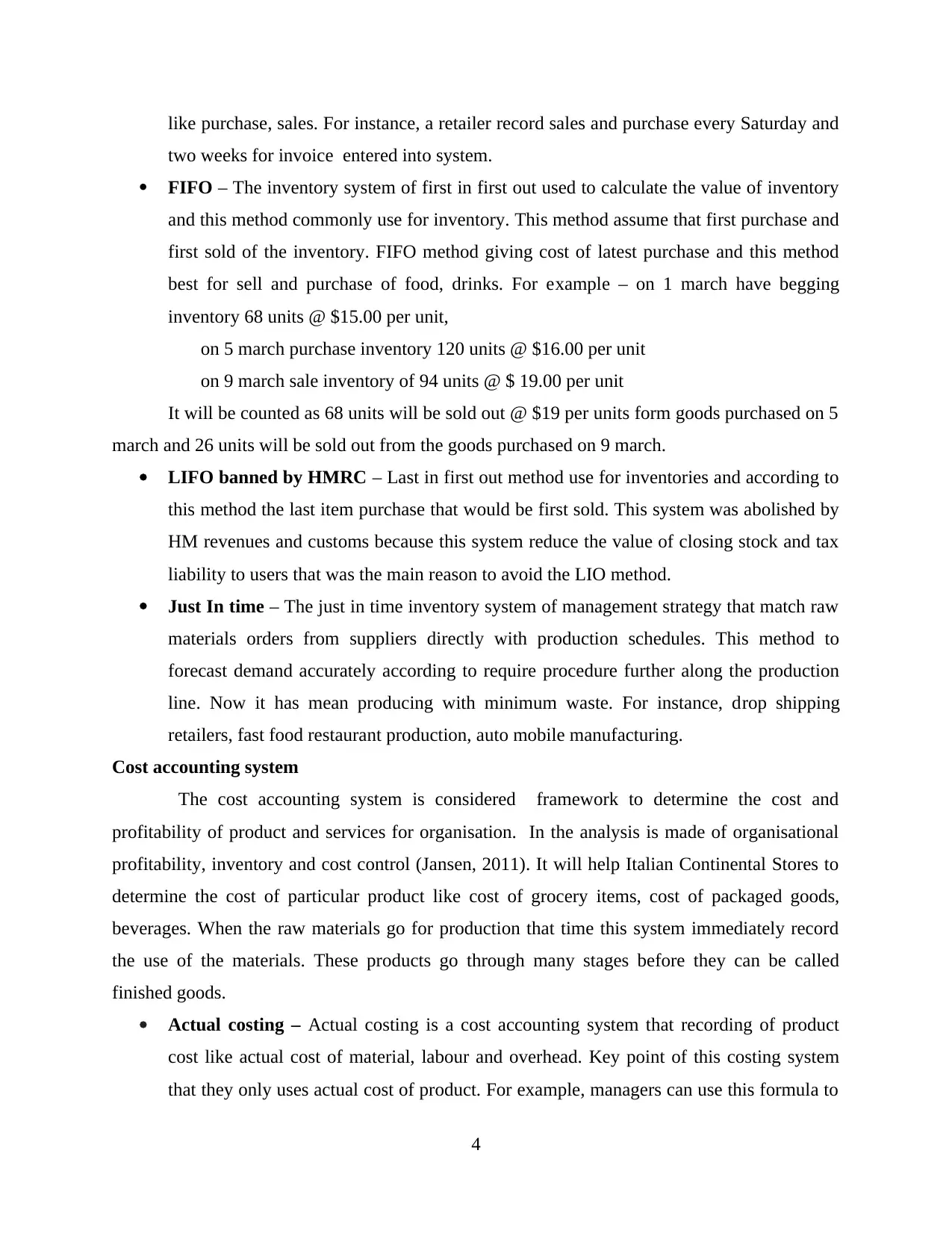
like purchase, sales. For instance, a retailer record sales and purchase every Saturday and
two weeks for invoice entered into system.
FIFO – The inventory system of first in first out used to calculate the value of inventory
and this method commonly use for inventory. This method assume that first purchase and
first sold of the inventory. FIFO method giving cost of latest purchase and this method
best for sell and purchase of food, drinks. For example – on 1 march have begging
inventory 68 units @ $15.00 per unit,
on 5 march purchase inventory 120 units @ $16.00 per unit
on 9 march sale inventory of 94 units @ $ 19.00 per unit
It will be counted as 68 units will be sold out @ $19 per units form goods purchased on 5
march and 26 units will be sold out from the goods purchased on 9 march.
LIFO banned by HMRC – Last in first out method use for inventories and according to
this method the last item purchase that would be first sold. This system was abolished by
HM revenues and customs because this system reduce the value of closing stock and tax
liability to users that was the main reason to avoid the LIO method.
Just In time – The just in time inventory system of management strategy that match raw
materials orders from suppliers directly with production schedules. This method to
forecast demand accurately according to require procedure further along the production
line. Now it has mean producing with minimum waste. For instance, drop shipping
retailers, fast food restaurant production, auto mobile manufacturing.
Cost accounting system
The cost accounting system is considered framework to determine the cost and
profitability of product and services for organisation. In the analysis is made of organisational
profitability, inventory and cost control (Jansen, 2011). It will help Italian Continental Stores to
determine the cost of particular product like cost of grocery items, cost of packaged goods,
beverages. When the raw materials go for production that time this system immediately record
the use of the materials. These products go through many stages before they can be called
finished goods.
Actual costing – Actual costing is a cost accounting system that recording of product
cost like actual cost of material, labour and overhead. Key point of this costing system
that they only uses actual cost of product. For example, managers can use this formula to
4
two weeks for invoice entered into system.
FIFO – The inventory system of first in first out used to calculate the value of inventory
and this method commonly use for inventory. This method assume that first purchase and
first sold of the inventory. FIFO method giving cost of latest purchase and this method
best for sell and purchase of food, drinks. For example – on 1 march have begging
inventory 68 units @ $15.00 per unit,
on 5 march purchase inventory 120 units @ $16.00 per unit
on 9 march sale inventory of 94 units @ $ 19.00 per unit
It will be counted as 68 units will be sold out @ $19 per units form goods purchased on 5
march and 26 units will be sold out from the goods purchased on 9 march.
LIFO banned by HMRC – Last in first out method use for inventories and according to
this method the last item purchase that would be first sold. This system was abolished by
HM revenues and customs because this system reduce the value of closing stock and tax
liability to users that was the main reason to avoid the LIO method.
Just In time – The just in time inventory system of management strategy that match raw
materials orders from suppliers directly with production schedules. This method to
forecast demand accurately according to require procedure further along the production
line. Now it has mean producing with minimum waste. For instance, drop shipping
retailers, fast food restaurant production, auto mobile manufacturing.
Cost accounting system
The cost accounting system is considered framework to determine the cost and
profitability of product and services for organisation. In the analysis is made of organisational
profitability, inventory and cost control (Jansen, 2011). It will help Italian Continental Stores to
determine the cost of particular product like cost of grocery items, cost of packaged goods,
beverages. When the raw materials go for production that time this system immediately record
the use of the materials. These products go through many stages before they can be called
finished goods.
Actual costing – Actual costing is a cost accounting system that recording of product
cost like actual cost of material, labour and overhead. Key point of this costing system
that they only uses actual cost of product. For example, managers can use this formula to
4
⊘ This is a preview!⊘
Do you want full access?
Subscribe today to unlock all pages.

Trusted by 1+ million students worldwide
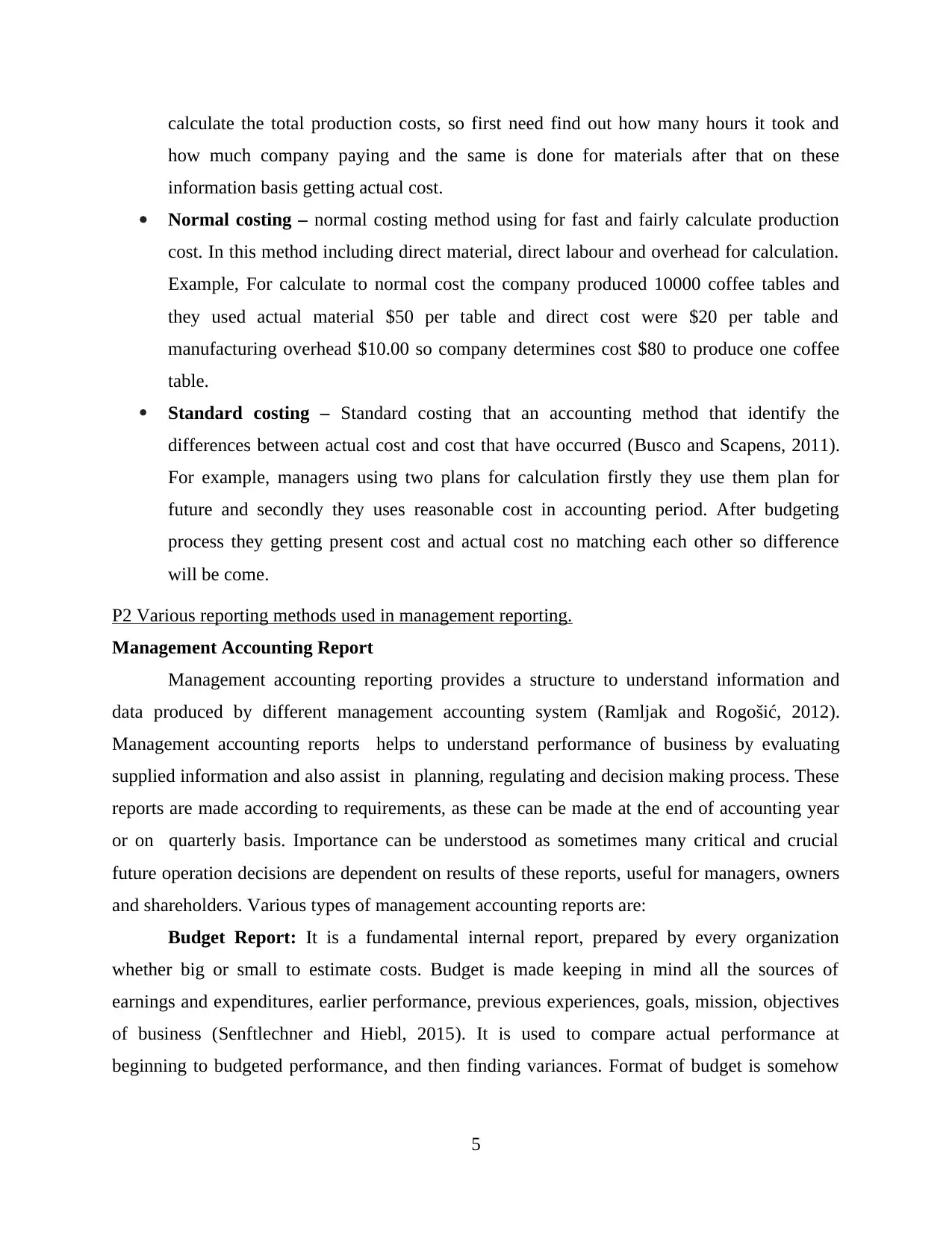
calculate the total production costs, so first need find out how many hours it took and
how much company paying and the same is done for materials after that on these
information basis getting actual cost.
Normal costing – normal costing method using for fast and fairly calculate production
cost. In this method including direct material, direct labour and overhead for calculation.
Example, For calculate to normal cost the company produced 10000 coffee tables and
they used actual material $50 per table and direct cost were $20 per table and
manufacturing overhead $10.00 so company determines cost $80 to produce one coffee
table.
Standard costing – Standard costing that an accounting method that identify the
differences between actual cost and cost that have occurred (Busco and Scapens, 2011).
For example, managers using two plans for calculation firstly they use them plan for
future and secondly they uses reasonable cost in accounting period. After budgeting
process they getting present cost and actual cost no matching each other so difference
will be come.
P2 Various reporting methods used in management reporting.
Management Accounting Report
Management accounting reporting provides a structure to understand information and
data produced by different management accounting system (Ramljak and Rogošić, 2012).
Management accounting reports helps to understand performance of business by evaluating
supplied information and also assist in planning, regulating and decision making process. These
reports are made according to requirements, as these can be made at the end of accounting year
or on quarterly basis. Importance can be understood as sometimes many critical and crucial
future operation decisions are dependent on results of these reports, useful for managers, owners
and shareholders. Various types of management accounting reports are:
Budget Report: It is a fundamental internal report, prepared by every organization
whether big or small to estimate costs. Budget is made keeping in mind all the sources of
earnings and expenditures, earlier performance, previous experiences, goals, mission, objectives
of business (Senftlechner and Hiebl, 2015). It is used to compare actual performance at
beginning to budgeted performance, and then finding variances. Format of budget is somehow
5
how much company paying and the same is done for materials after that on these
information basis getting actual cost.
Normal costing – normal costing method using for fast and fairly calculate production
cost. In this method including direct material, direct labour and overhead for calculation.
Example, For calculate to normal cost the company produced 10000 coffee tables and
they used actual material $50 per table and direct cost were $20 per table and
manufacturing overhead $10.00 so company determines cost $80 to produce one coffee
table.
Standard costing – Standard costing that an accounting method that identify the
differences between actual cost and cost that have occurred (Busco and Scapens, 2011).
For example, managers using two plans for calculation firstly they use them plan for
future and secondly they uses reasonable cost in accounting period. After budgeting
process they getting present cost and actual cost no matching each other so difference
will be come.
P2 Various reporting methods used in management reporting.
Management Accounting Report
Management accounting reporting provides a structure to understand information and
data produced by different management accounting system (Ramljak and Rogošić, 2012).
Management accounting reports helps to understand performance of business by evaluating
supplied information and also assist in planning, regulating and decision making process. These
reports are made according to requirements, as these can be made at the end of accounting year
or on quarterly basis. Importance can be understood as sometimes many critical and crucial
future operation decisions are dependent on results of these reports, useful for managers, owners
and shareholders. Various types of management accounting reports are:
Budget Report: It is a fundamental internal report, prepared by every organization
whether big or small to estimate costs. Budget is made keeping in mind all the sources of
earnings and expenditures, earlier performance, previous experiences, goals, mission, objectives
of business (Senftlechner and Hiebl, 2015). It is used to compare actual performance at
beginning to budgeted performance, and then finding variances. Format of budget is somehow
5
Paraphrase This Document
Need a fresh take? Get an instant paraphrase of this document with our AI Paraphraser
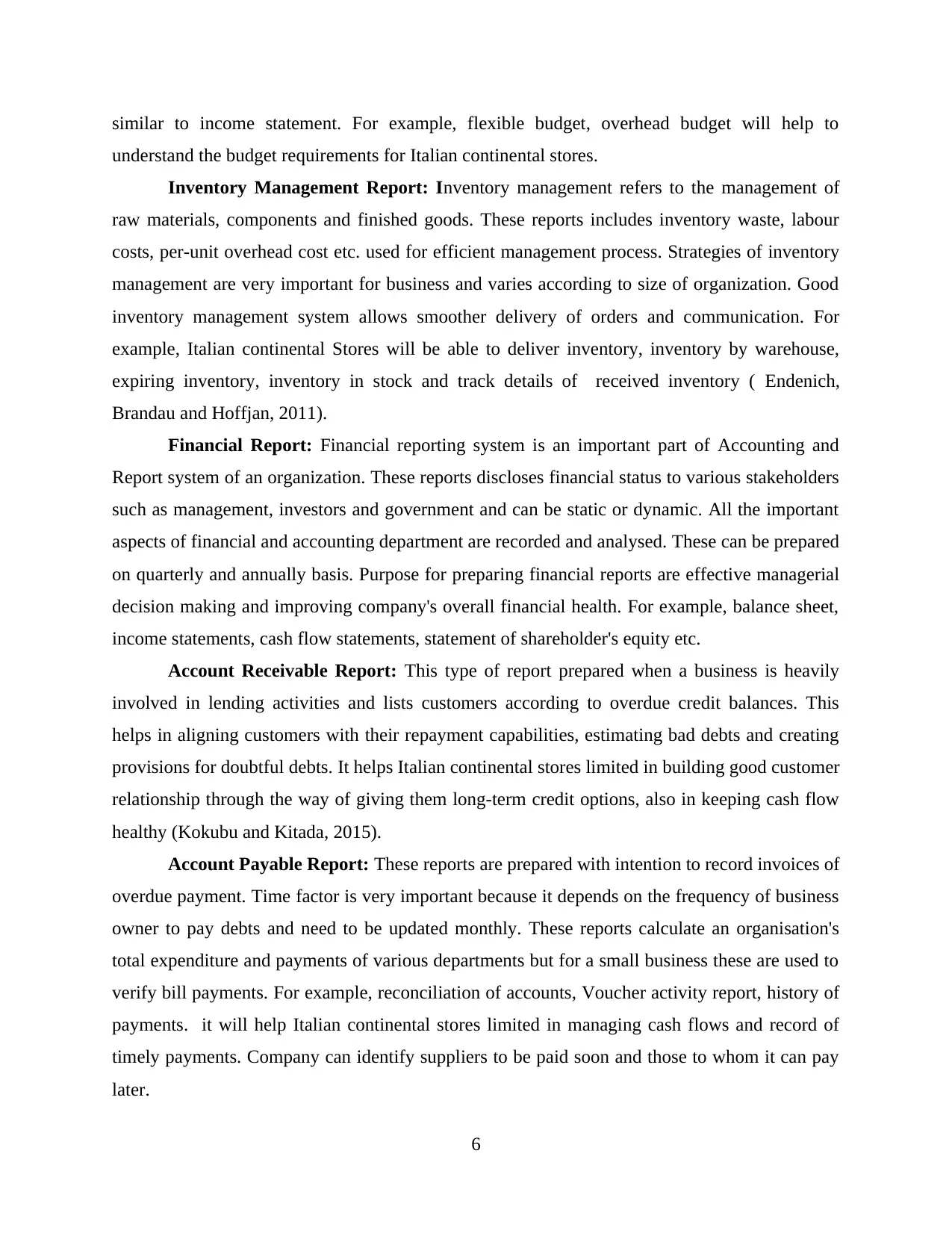
similar to income statement. For example, flexible budget, overhead budget will help to
understand the budget requirements for Italian continental stores.
Inventory Management Report: Inventory management refers to the management of
raw materials, components and finished goods. These reports includes inventory waste, labour
costs, per-unit overhead cost etc. used for efficient management process. Strategies of inventory
management are very important for business and varies according to size of organization. Good
inventory management system allows smoother delivery of orders and communication. For
example, Italian continental Stores will be able to deliver inventory, inventory by warehouse,
expiring inventory, inventory in stock and track details of received inventory ( Endenich,
Brandau and Hoffjan, 2011).
Financial Report: Financial reporting system is an important part of Accounting and
Report system of an organization. These reports discloses financial status to various stakeholders
such as management, investors and government and can be static or dynamic. All the important
aspects of financial and accounting department are recorded and analysed. These can be prepared
on quarterly and annually basis. Purpose for preparing financial reports are effective managerial
decision making and improving company's overall financial health. For example, balance sheet,
income statements, cash flow statements, statement of shareholder's equity etc.
Account Receivable Report: This type of report prepared when a business is heavily
involved in lending activities and lists customers according to overdue credit balances. This
helps in aligning customers with their repayment capabilities, estimating bad debts and creating
provisions for doubtful debts. It helps Italian continental stores limited in building good customer
relationship through the way of giving them long-term credit options, also in keeping cash flow
healthy (Kokubu and Kitada, 2015).
Account Payable Report: These reports are prepared with intention to record invoices of
overdue payment. Time factor is very important because it depends on the frequency of business
owner to pay debts and need to be updated monthly. These reports calculate an organisation's
total expenditure and payments of various departments but for a small business these are used to
verify bill payments. For example, reconciliation of accounts, Voucher activity report, history of
payments. it will help Italian continental stores limited in managing cash flows and record of
timely payments. Company can identify suppliers to be paid soon and those to whom it can pay
later.
6
understand the budget requirements for Italian continental stores.
Inventory Management Report: Inventory management refers to the management of
raw materials, components and finished goods. These reports includes inventory waste, labour
costs, per-unit overhead cost etc. used for efficient management process. Strategies of inventory
management are very important for business and varies according to size of organization. Good
inventory management system allows smoother delivery of orders and communication. For
example, Italian continental Stores will be able to deliver inventory, inventory by warehouse,
expiring inventory, inventory in stock and track details of received inventory ( Endenich,
Brandau and Hoffjan, 2011).
Financial Report: Financial reporting system is an important part of Accounting and
Report system of an organization. These reports discloses financial status to various stakeholders
such as management, investors and government and can be static or dynamic. All the important
aspects of financial and accounting department are recorded and analysed. These can be prepared
on quarterly and annually basis. Purpose for preparing financial reports are effective managerial
decision making and improving company's overall financial health. For example, balance sheet,
income statements, cash flow statements, statement of shareholder's equity etc.
Account Receivable Report: This type of report prepared when a business is heavily
involved in lending activities and lists customers according to overdue credit balances. This
helps in aligning customers with their repayment capabilities, estimating bad debts and creating
provisions for doubtful debts. It helps Italian continental stores limited in building good customer
relationship through the way of giving them long-term credit options, also in keeping cash flow
healthy (Kokubu and Kitada, 2015).
Account Payable Report: These reports are prepared with intention to record invoices of
overdue payment. Time factor is very important because it depends on the frequency of business
owner to pay debts and need to be updated monthly. These reports calculate an organisation's
total expenditure and payments of various departments but for a small business these are used to
verify bill payments. For example, reconciliation of accounts, Voucher activity report, history of
payments. it will help Italian continental stores limited in managing cash flows and record of
timely payments. Company can identify suppliers to be paid soon and those to whom it can pay
later.
6
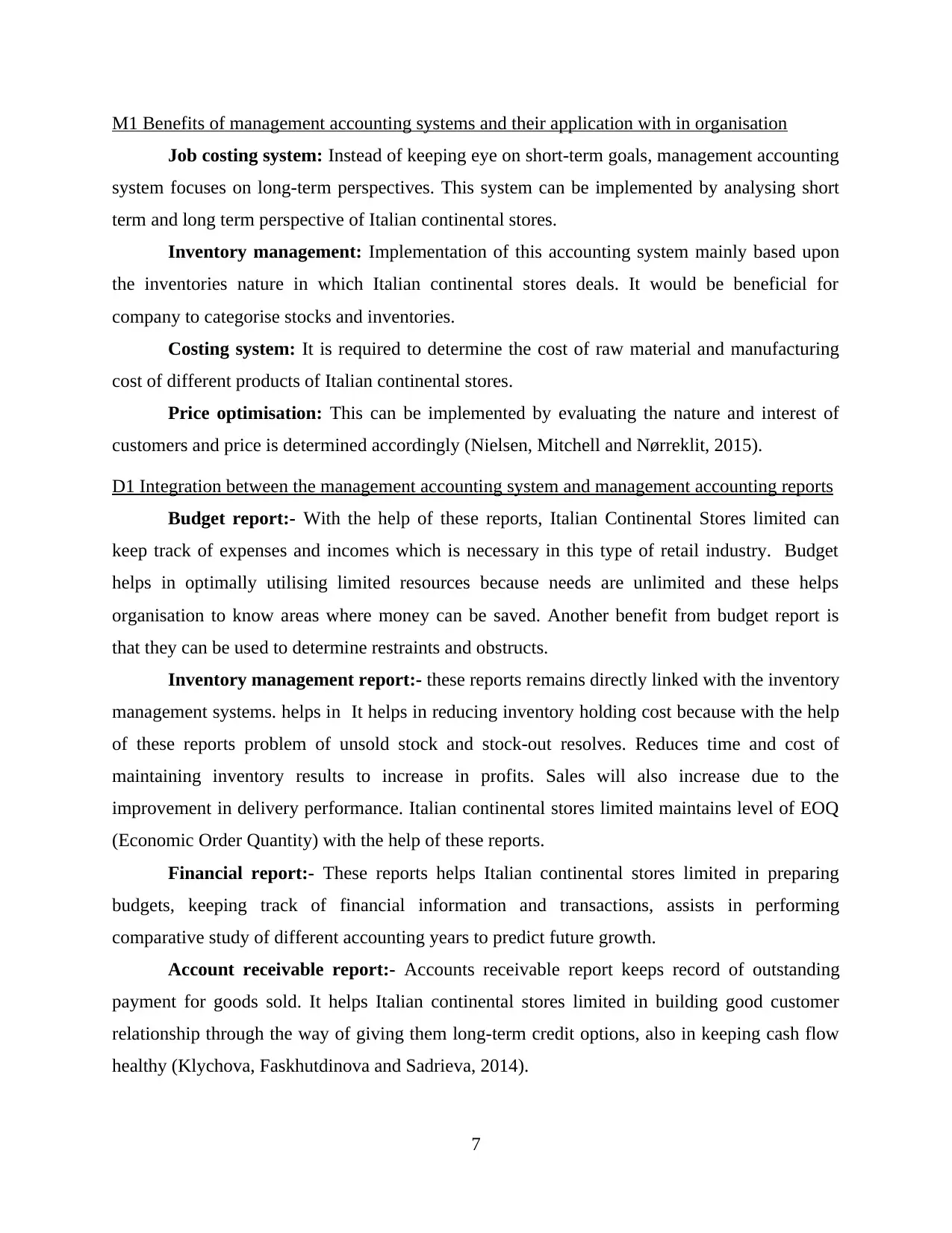
M1 Benefits of management accounting systems and their application with in organisation
Job costing system: Instead of keeping eye on short-term goals, management accounting
system focuses on long-term perspectives. This system can be implemented by analysing short
term and long term perspective of Italian continental stores.
Inventory management: Implementation of this accounting system mainly based upon
the inventories nature in which Italian continental stores deals. It would be beneficial for
company to categorise stocks and inventories.
Costing system: It is required to determine the cost of raw material and manufacturing
cost of different products of Italian continental stores.
Price optimisation: This can be implemented by evaluating the nature and interest of
customers and price is determined accordingly (Nielsen, Mitchell and Nørreklit, 2015).
D1 Integration between the management accounting system and management accounting reports
Budget report:- With the help of these reports, Italian Continental Stores limited can
keep track of expenses and incomes which is necessary in this type of retail industry. Budget
helps in optimally utilising limited resources because needs are unlimited and these helps
organisation to know areas where money can be saved. Another benefit from budget report is
that they can be used to determine restraints and obstructs.
Inventory management report:- these reports remains directly linked with the inventory
management systems. helps in It helps in reducing inventory holding cost because with the help
of these reports problem of unsold stock and stock-out resolves. Reduces time and cost of
maintaining inventory results to increase in profits. Sales will also increase due to the
improvement in delivery performance. Italian continental stores limited maintains level of EOQ
(Economic Order Quantity) with the help of these reports.
Financial report:- These reports helps Italian continental stores limited in preparing
budgets, keeping track of financial information and transactions, assists in performing
comparative study of different accounting years to predict future growth.
Account receivable report:- Accounts receivable report keeps record of outstanding
payment for goods sold. It helps Italian continental stores limited in building good customer
relationship through the way of giving them long-term credit options, also in keeping cash flow
healthy (Klychova, Faskhutdinova and Sadrieva, 2014).
7
Job costing system: Instead of keeping eye on short-term goals, management accounting
system focuses on long-term perspectives. This system can be implemented by analysing short
term and long term perspective of Italian continental stores.
Inventory management: Implementation of this accounting system mainly based upon
the inventories nature in which Italian continental stores deals. It would be beneficial for
company to categorise stocks and inventories.
Costing system: It is required to determine the cost of raw material and manufacturing
cost of different products of Italian continental stores.
Price optimisation: This can be implemented by evaluating the nature and interest of
customers and price is determined accordingly (Nielsen, Mitchell and Nørreklit, 2015).
D1 Integration between the management accounting system and management accounting reports
Budget report:- With the help of these reports, Italian Continental Stores limited can
keep track of expenses and incomes which is necessary in this type of retail industry. Budget
helps in optimally utilising limited resources because needs are unlimited and these helps
organisation to know areas where money can be saved. Another benefit from budget report is
that they can be used to determine restraints and obstructs.
Inventory management report:- these reports remains directly linked with the inventory
management systems. helps in It helps in reducing inventory holding cost because with the help
of these reports problem of unsold stock and stock-out resolves. Reduces time and cost of
maintaining inventory results to increase in profits. Sales will also increase due to the
improvement in delivery performance. Italian continental stores limited maintains level of EOQ
(Economic Order Quantity) with the help of these reports.
Financial report:- These reports helps Italian continental stores limited in preparing
budgets, keeping track of financial information and transactions, assists in performing
comparative study of different accounting years to predict future growth.
Account receivable report:- Accounts receivable report keeps record of outstanding
payment for goods sold. It helps Italian continental stores limited in building good customer
relationship through the way of giving them long-term credit options, also in keeping cash flow
healthy (Klychova, Faskhutdinova and Sadrieva, 2014).
7
⊘ This is a preview!⊘
Do you want full access?
Subscribe today to unlock all pages.

Trusted by 1+ million students worldwide
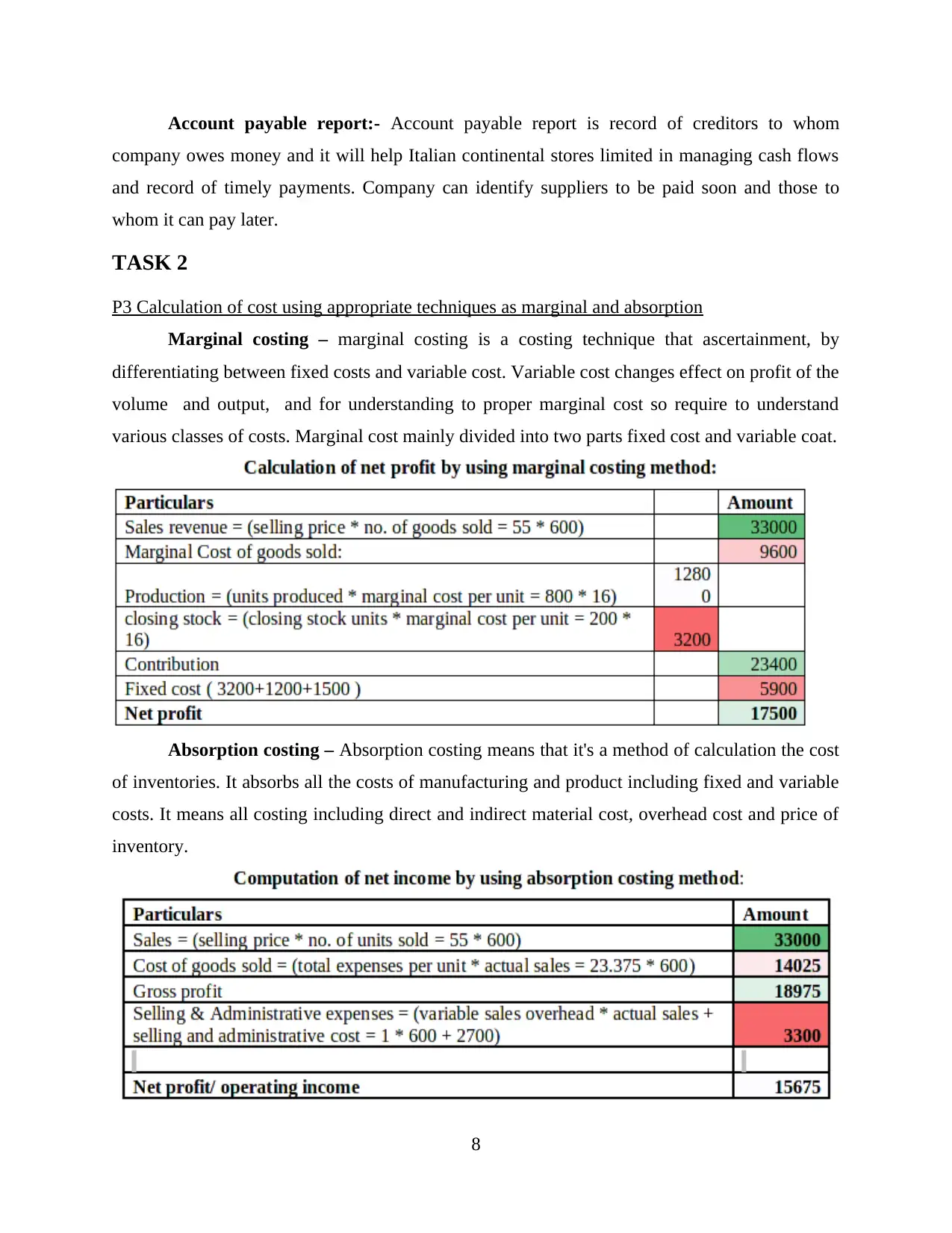
Account payable report:- Account payable report is record of creditors to whom
company owes money and it will help Italian continental stores limited in managing cash flows
and record of timely payments. Company can identify suppliers to be paid soon and those to
whom it can pay later.
TASK 2
P3 Calculation of cost using appropriate techniques as marginal and absorption
Marginal costing – marginal costing is a costing technique that ascertainment, by
differentiating between fixed costs and variable cost. Variable cost changes effect on profit of the
volume and output, and for understanding to proper marginal cost so require to understand
various classes of costs. Marginal cost mainly divided into two parts fixed cost and variable coat.
Absorption costing – Absorption costing means that it's a method of calculation the cost
of inventories. It absorbs all the costs of manufacturing and product including fixed and variable
costs. It means all costing including direct and indirect material cost, overhead cost and price of
inventory.
8
company owes money and it will help Italian continental stores limited in managing cash flows
and record of timely payments. Company can identify suppliers to be paid soon and those to
whom it can pay later.
TASK 2
P3 Calculation of cost using appropriate techniques as marginal and absorption
Marginal costing – marginal costing is a costing technique that ascertainment, by
differentiating between fixed costs and variable cost. Variable cost changes effect on profit of the
volume and output, and for understanding to proper marginal cost so require to understand
various classes of costs. Marginal cost mainly divided into two parts fixed cost and variable coat.
Absorption costing – Absorption costing means that it's a method of calculation the cost
of inventories. It absorbs all the costs of manufacturing and product including fixed and variable
costs. It means all costing including direct and indirect material cost, overhead cost and price of
inventory.
8
Paraphrase This Document
Need a fresh take? Get an instant paraphrase of this document with our AI Paraphraser
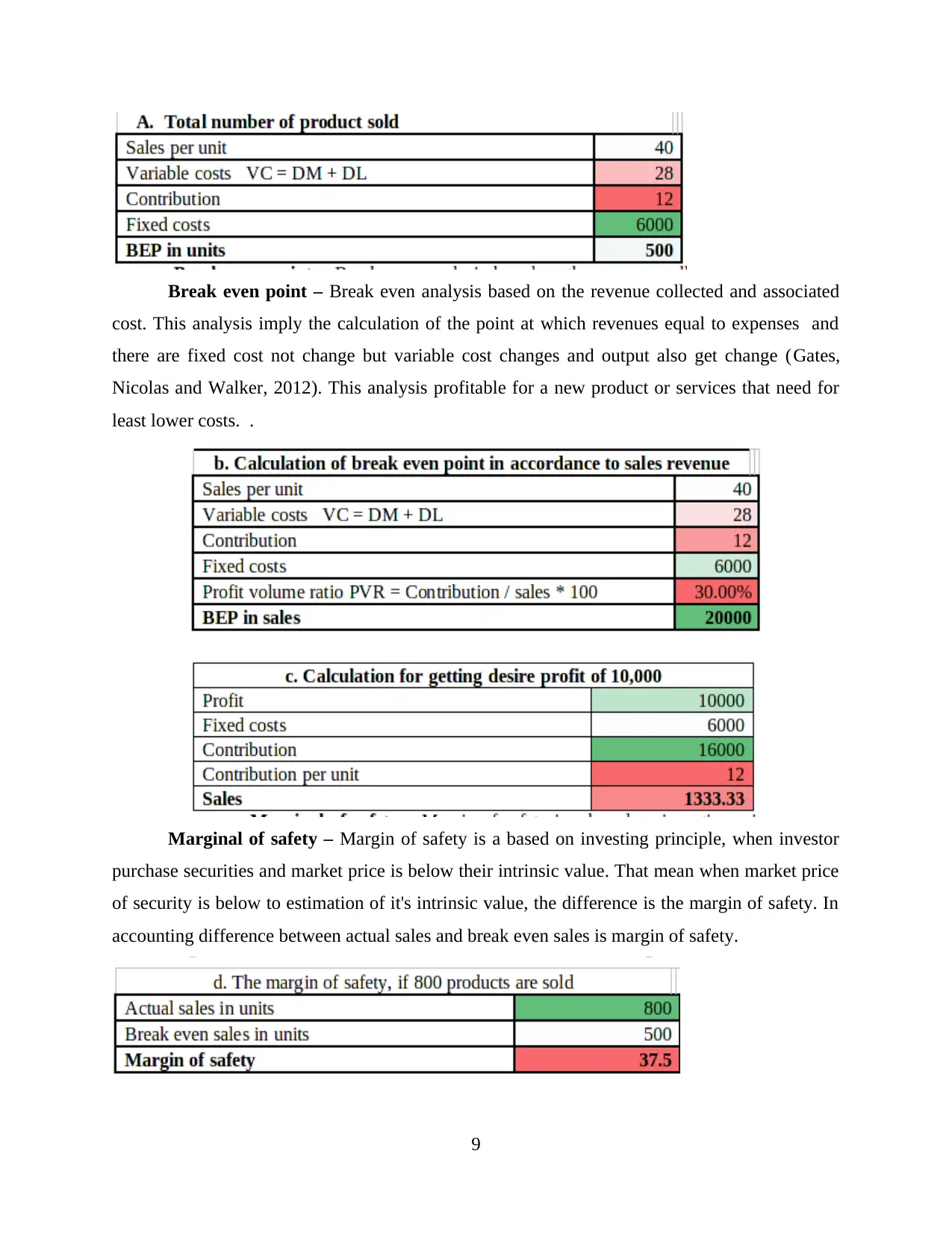
Break even point – Break even analysis based on the revenue collected and associated
cost. This analysis imply the calculation of the point at which revenues equal to expenses and
there are fixed cost not change but variable cost changes and output also get change (Gates,
Nicolas and Walker, 2012). This analysis profitable for a new product or services that need for
least lower costs. .
Marginal of safety – Margin of safety is a based on investing principle, when investor
purchase securities and market price is below their intrinsic value. That mean when market price
of security is below to estimation of it's intrinsic value, the difference is the margin of safety. In
accounting difference between actual sales and break even sales is margin of safety.
9
cost. This analysis imply the calculation of the point at which revenues equal to expenses and
there are fixed cost not change but variable cost changes and output also get change (Gates,
Nicolas and Walker, 2012). This analysis profitable for a new product or services that need for
least lower costs. .
Marginal of safety – Margin of safety is a based on investing principle, when investor
purchase securities and market price is below their intrinsic value. That mean when market price
of security is below to estimation of it's intrinsic value, the difference is the margin of safety. In
accounting difference between actual sales and break even sales is margin of safety.
9
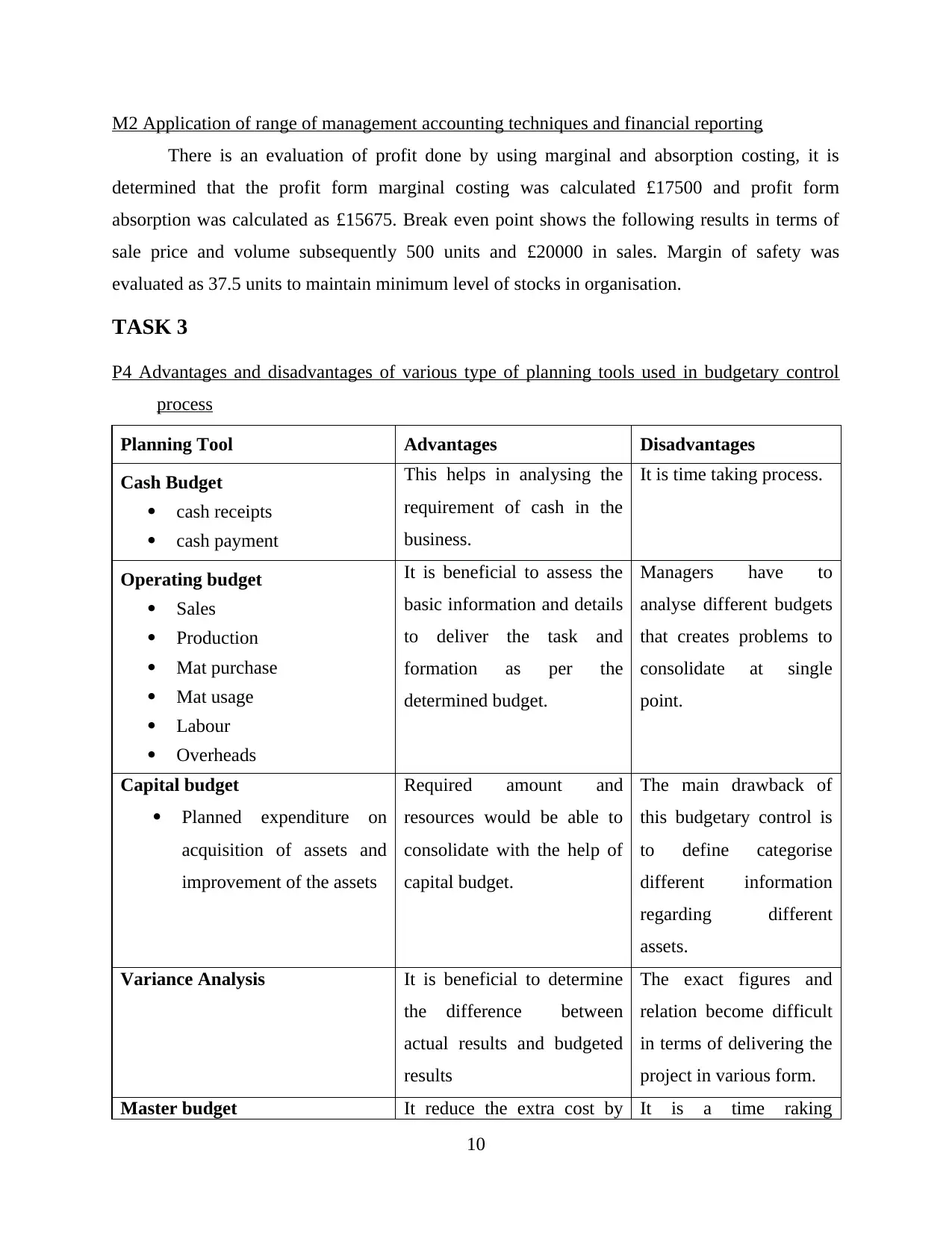
M2 Application of range of management accounting techniques and financial reporting
There is an evaluation of profit done by using marginal and absorption costing, it is
determined that the profit form marginal costing was calculated £17500 and profit form
absorption was calculated as £15675. Break even point shows the following results in terms of
sale price and volume subsequently 500 units and £20000 in sales. Margin of safety was
evaluated as 37.5 units to maintain minimum level of stocks in organisation.
TASK 3
P4 Advantages and disadvantages of various type of planning tools used in budgetary control
process
Planning Tool Advantages Disadvantages
Cash Budget
cash receipts
cash payment
This helps in analysing the
requirement of cash in the
business.
It is time taking process.
Operating budget
Sales
Production
Mat purchase
Mat usage
Labour
Overheads
It is beneficial to assess the
basic information and details
to deliver the task and
formation as per the
determined budget.
Managers have to
analyse different budgets
that creates problems to
consolidate at single
point.
Capital budget
Planned expenditure on
acquisition of assets and
improvement of the assets
Required amount and
resources would be able to
consolidate with the help of
capital budget.
The main drawback of
this budgetary control is
to define categorise
different information
regarding different
assets.
Variance Analysis It is beneficial to determine
the difference between
actual results and budgeted
results
The exact figures and
relation become difficult
in terms of delivering the
project in various form.
Master budget It reduce the extra cost by It is a time raking
10
There is an evaluation of profit done by using marginal and absorption costing, it is
determined that the profit form marginal costing was calculated £17500 and profit form
absorption was calculated as £15675. Break even point shows the following results in terms of
sale price and volume subsequently 500 units and £20000 in sales. Margin of safety was
evaluated as 37.5 units to maintain minimum level of stocks in organisation.
TASK 3
P4 Advantages and disadvantages of various type of planning tools used in budgetary control
process
Planning Tool Advantages Disadvantages
Cash Budget
cash receipts
cash payment
This helps in analysing the
requirement of cash in the
business.
It is time taking process.
Operating budget
Sales
Production
Mat purchase
Mat usage
Labour
Overheads
It is beneficial to assess the
basic information and details
to deliver the task and
formation as per the
determined budget.
Managers have to
analyse different budgets
that creates problems to
consolidate at single
point.
Capital budget
Planned expenditure on
acquisition of assets and
improvement of the assets
Required amount and
resources would be able to
consolidate with the help of
capital budget.
The main drawback of
this budgetary control is
to define categorise
different information
regarding different
assets.
Variance Analysis It is beneficial to determine
the difference between
actual results and budgeted
results
The exact figures and
relation become difficult
in terms of delivering the
project in various form.
Master budget It reduce the extra cost by It is a time raking
10
⊘ This is a preview!⊘
Do you want full access?
Subscribe today to unlock all pages.

Trusted by 1+ million students worldwide
1 out of 17
Related Documents
Your All-in-One AI-Powered Toolkit for Academic Success.
+13062052269
info@desklib.com
Available 24*7 on WhatsApp / Email
![[object Object]](/_next/static/media/star-bottom.7253800d.svg)
Unlock your academic potential
Copyright © 2020–2025 A2Z Services. All Rights Reserved. Developed and managed by ZUCOL.





